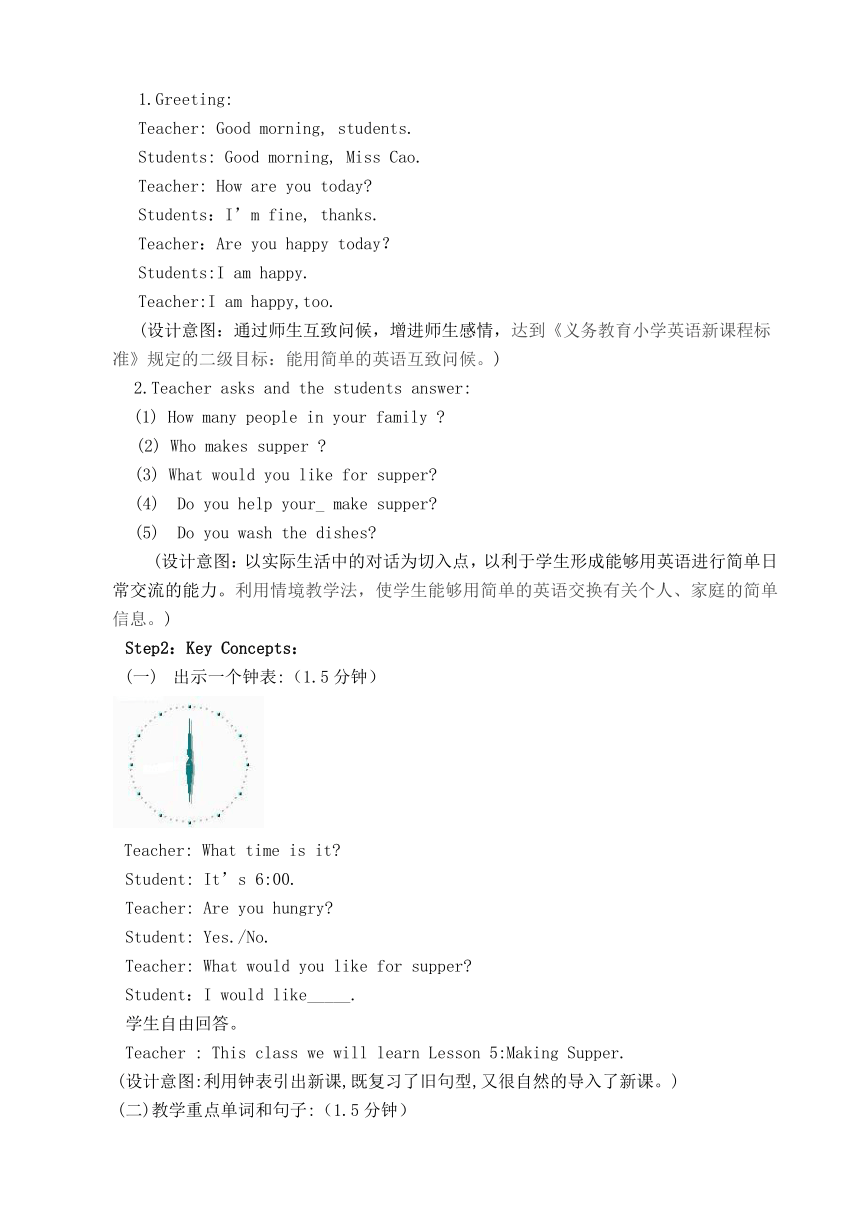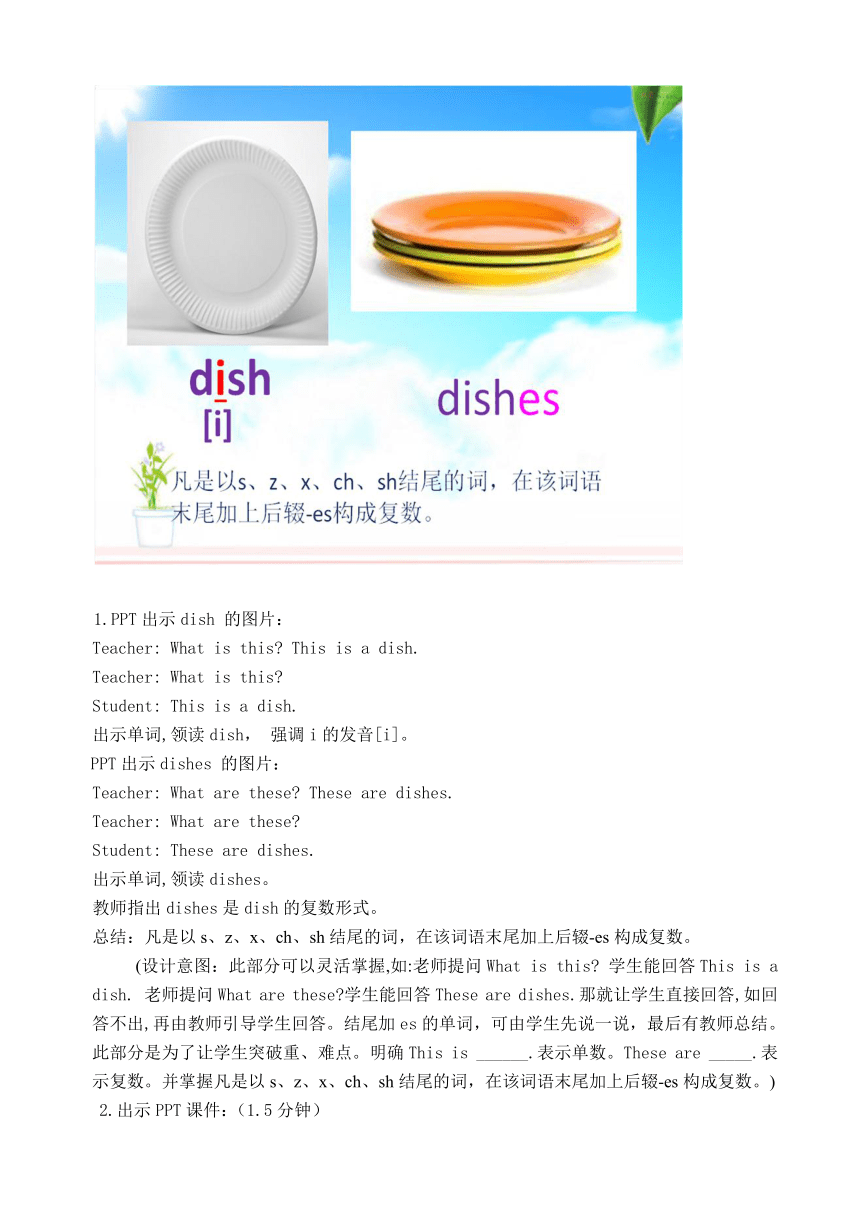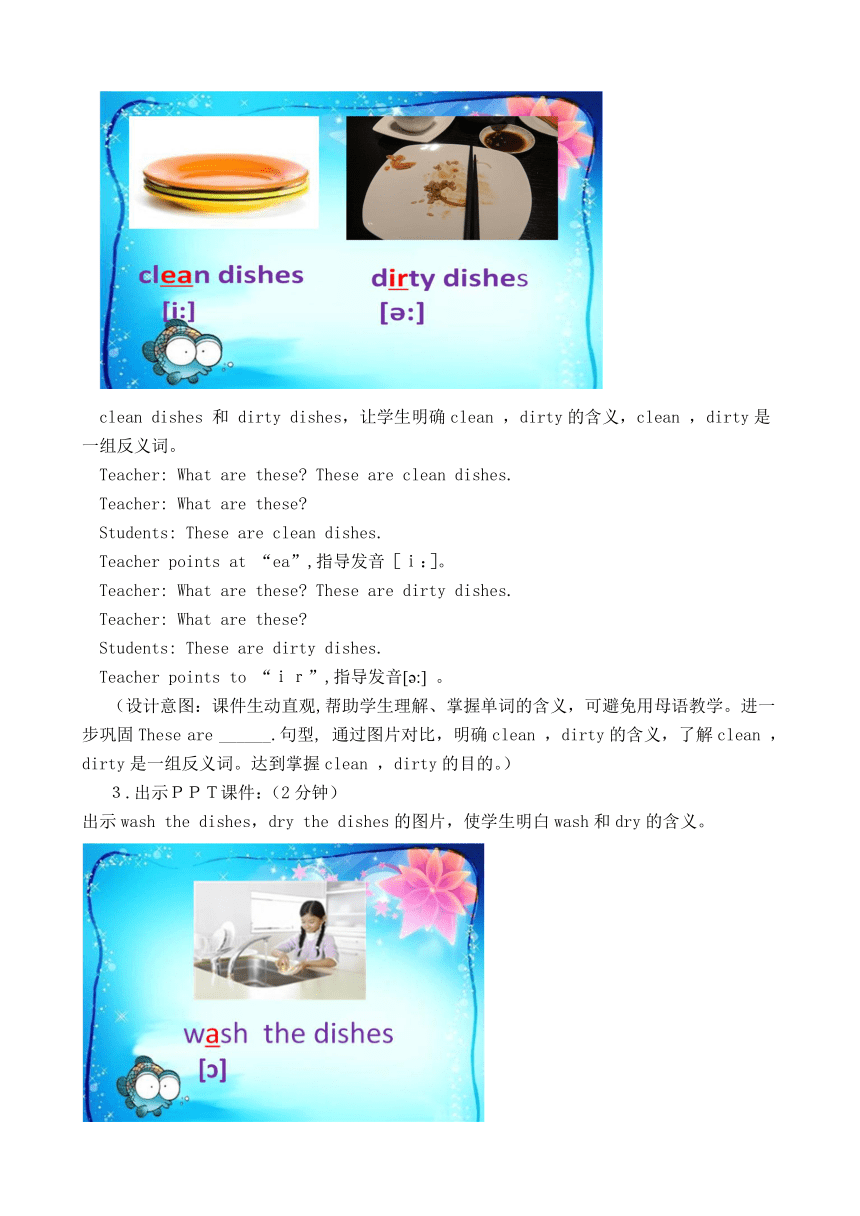Lesson3 Making Breakfast 教案
文档属性
| 名称 | Lesson3 Making Breakfast 教案 |

|
|
| 格式 | zip | ||
| 文件大小 | 6.7MB | ||
| 资源类型 | 教案 | ||
| 版本资源 | 冀教版(三年级起点) | ||
| 科目 | 英语 | ||
| 更新时间 | 2020-01-07 06:22:59 | ||
图片预览





文档简介
Lesson3 Making Breakfast
一、课型:新授课
二、教学设计:
整体设计思路:
在设计时,我利用课件、实物、情景会话、小组合作学习等方式进行教学,课件直观、生动形象,实物、情景会话接近生活实际,唤起学生的好奇心,激发和培养学生学习英语的兴趣,培养了学生的观察、记忆、思维能力;小组合作学习,培养了学生的合作精神;饮食文化的学习,帮助学生了解了中西方饮食文化的差异;情景会话为学生的终身学习和发展打下良好的基础;教师通过听、说、读、写技能训练,使学生形成一定的综合语言运用能力。
指导依据说明:
在设计课时,我紧紧围绕2012《义务教育小学英语新课程标准》规定的基础教育阶段英语课程的任务和二级目标进行设计。
基础教育阶段英语课程的任务是:激发和培养学生学习英语的兴趣,使学生树立自信心,养成良好的学习习惯和形成有效的学习策略,发展自主学习的能力和合作精神;使学生掌握一定的英语基础知识和听、说、读、写技能,形成一定的综合语言运用能力;培养学生的观察、记忆、思维、想象能力和创新精神;帮助学生了解世界和中西方文化的差异,拓展视野,培养爱国主义精神,形成健康的人生观,为他们的终身学习和发展打下良好的基础。
二级目标:对英语学习有持续的兴趣和爱好。能用简单的英语互致问候、交换有关个人、家庭和朋友的简单信息。能根据所学内容表演小对话或歌谣。能在图片的帮助下听懂、读懂并讲述简单的故事。能根据图片或提示写简单的句子。在学习中乐于参与、积极合作、主动请教。乐于了解异国文化、习俗。
依据英语教学法:利用实物形象的表明一个新概念;利用图片使学生把新概念掌握好;利用形体动作,例如:洗盘子、擦盘子等使学生明确新概念;进行角色表演有利于学生把所学知识运用到实际生活,在学生表演时,每节课找几组进行表演,要让学生在小组内享受学习的乐趣,在自编对话时,要让学生发挥其想象力;学生在练习时,教师要观察学生练习并给予指导;利用国际音标帮助教学,使学生掌握字母或字母组合的发音规律,有利于学生自读单词。
教学背景分析:
单元内容分析:
此课是冀教版小学英语第七册第一单元 Lesson3 Making Breakast。本单元的主题是李明来到加拿大学习英语,他和Jenny一家住在一起,并接触了加拿大的学校教育、民族风情及饮食文化。本课是李明在Jenny家学习一些有关家务的词汇及句型。并介绍了做饭和洗盘子等饮食方面的内容。
学情分析:
六年级学生已学过五年的英语,已经认识到学英语的重要性,六年级的学生开始由被动学习转变为主动学习。因此,教师要注重培养学生的自主学习能力,引导学生在上课时认真听讲,并能主动参与到课堂教学中来。在教学中我采用情境教学法,让学生在实践中体会学习英语的乐趣,通过师生问答、生生问答等方式,让学生在多说、多练、多做中学会口语,掌握句型,提高学习效率,同时增进对西方文化的了解。
教学目标分析:
(一)?知识目标:
1.能够会读、会拼写单词dishes盘子、clean干净、dirty 脏、wash 洗、 dry擦干。??
2.能够认读:cabbage洋白菜、? peas豌豆、 onions洋葱、 and carrots胡萝卜。
3.学生能够说出并且听懂一下句子:
This is ______.这是____.
These are _____.这些是____.
(二) 学习策略目标:
在教学中,我利用实物、图片等信息帮助学生形成良好的认知策略,利用小组合作学习,帮助学生形成良好的调控策略和交际策略,课件、光盘教学是资源策略,通过这些策略,培养学生的自主学习能力,为学生的终身学习奠定基础。
(三)情感态度目标:
1.利用实物、图片、情景会话、小组合作学习等,激发学生的学习兴趣,培养学生的合作精神。
2.通过情景会话,小组表演,培养学生爱劳动、做家务的意识。
(四)文化意识目标:
向学生渗透中西饮食文化的差异。
教学重点
1.在真实语境下,使学生能够会读、会拼写单词dishes盘子、clean干净、dirty 脏、wash 洗、 dry擦干。
2.在真实语境下,使学生能够熟练运用句型 This is ____.These are ______.
教学难点
在真实语境下,使学生能够熟练运用句型:
This is ______.这是____.
These are _____.这些是____.
Let’s help___(name)____(verb)___(noun).
教具准备:
实物(水、盘子等) PPT
三、教学过程:
Step1:Class Opening and Review(5分钟)
1.Greeting:
Teacher: Good morning, students.
Students: Good morning, Miss Cao.
Teacher: How are you today?
Students:I’m fine, thanks.
Teacher:Are you happy today?
Students:I am happy.
Teacher:I am happy,too.
(设计意图:通过师生互致问候,增进师生感情,达到《义务教育小学英语新课程标准》规定的二级目标:能用简单的英语互致问候。)
2.Teacher asks and the students answer:
(1) How many people in your family ?
(2) Who makes supper ?
(3) What would you like for supper?
(4)?Do you help your_ make supper?
(5)?Do you wash the dishes?
(设计意图:以实际生活中的对话为切入点,以利于学生形成能够用英语进行简单日常交流的能力。利用情境教学法,使学生能够用简单的英语交换有关个人、家庭的简单信息。)
Step2:Key Concepts:
出示一个钟表:(1.5分钟)
Teacher: What time is it?
Student: It’s 6:00.
Teacher: Are you hungry?
Student: Yes./No.
Teacher: What would you like for supper?
Student:I would like_____.
学生自由回答。
Teacher : This class we will learn Lesson 5:Making Supper.
(设计意图:利用钟表引出新课,既复习了旧句型,又很自然的导入了新课。)
(二)教学重点单词和句子:(1.5分钟)
1.PPT出示dish 的图片:
Teacher: What is this? This is a dish.
Teacher: What is this?
Student: This is a dish.
出示单词,领读dish, 强调i的发音[i]。
PPT出示dishes 的图片:
Teacher: What are these? These are dishes.
Teacher: What are these?
Student: These are dishes.
出示单词,领读dishes。
教师指出dishes是dish的复数形式。
总结:凡是以s、z、x、ch、sh结尾的词,在该词语末尾加上后辍-es构成复数。
(设计意图:此部分可以灵活掌握,如:老师提问What is this? 学生能回答This is a dish. 老师提问What are these?学生能回答These are dishes.那就让学生直接回答,如回答不出,再由教师引导学生回答。结尾加es的单词,可由学生先说一说,最后有教师总结。此部分是为了让学生突破重、难点。明确This is ______.表示单数。These are _____.表示复数。并掌握凡是以s、z、x、ch、sh结尾的词,在该词语末尾加上后辍-es构成复数。)
2.出示PPT课件:(1.5分钟)
clean dishes 和 dirty dishes,让学生明确clean ,dirty的含义,clean ,dirty是一组反义词。
Teacher: What are these? These are clean dishes.
Teacher: What are these?
Students: These are clean dishes.
Teacher points at “ea”,指导发音[i:]。
Teacher: What are these? These are dirty dishes.
Teacher: What are these?
Students: These are dirty dishes.
Teacher points to “ir”,指导发音[?:] 。
(设计意图:课件生动直观,帮助学生理解、掌握单词的含义,可避免用母语教学。进一步巩固These are ______.句型, 通过图片对比,明确clean ,dirty的含义,了解clean ,dirty是一组反义词。达到掌握clean ,dirty的目的。)
3.出示PPT课件:(2分钟)
出示wash the dishes,dry the dishes的图片,使学生明白wash和dry的含义。
Teacher points at“wash”指导读音,强调“a”的发音是[?] 。
Teacher:What is the girl doing?
Student: She is washing the dishes.
Teacher:Do you usually help your mother wash the dishes?
Student:Yes, I usually help my mother wash the dishes.
Teacher points at“dry”,指导读音,强调“y”的发音是[ai] 。
Teacher:What is the girl doing?
Student: She is drying the dishes.
Teacher:Can you dry the dishes?
Student:Yes, I can.
(设计意图:利用图片帮助学生理解单词含义,师生进行问答练习,在教学中注重元音的教学,并结合生活实际进行会话,培养学生的日常会话能力。)
4.PPT出示cabbage, peas, onions的图片。(2分钟)
Teacher points at“cabbage”,指导读音,强调“a”的发音,两个a的发音是不同的 。
Teacher points at“peas”,指导读音,强调“ea”的发音。
Teacher points at“onions”,指导读音,强调第一个“o”的发音。
出示实物:cabbage, peas, onions.
Teacher points at the objects and ask:
Teacher: What is this?
Student: This is cabbage.
Teacher: What are these?
Student: These are onions/carrots /peas.
Teacher: Please pass the peas to name.
(设计意图:利用课件教授新单词,注重元音及元音字母组合的发音规律,进一步巩固练习重点句型This is ____. These are ___.)
5.PPT出示:(1.5分钟)
Read and judge.
判断画线部分读音是“T”否“F”相同。
1.[T] [F] cabbage carrots
2.[T] [F] cabbage carrots
3.[T] [F] peas clean
4.[T] [F] onions do
5.[T] [F] dish is
6.[T] [F] dirty skirt
7.[T] [F] wash what
8.[T] [F] dry dirty
(设计意图:通过检测,进一步帮助学生掌握元音字母及元音字母组合的正确标准的英语发音规律,对学生今后记忆单词以及试读单词有很大的帮助)
(三)Listen to the audiotape and follow it.
1. Teach No1.(6分钟)
Teacher: First listen to the audiotape carefully .(第一遍学生认真听录音)。
Teacher: listen to the audiotape and follow it.(第二遍学生认真听录音并跟读。)
Teacher:Can you ask some questions?(学生自由提问,找自愿回答的同学回答)
Such as:
What time is it?
What’s for supper?
Where is the cabbage?
Where are the peas?
Where are the onions?
Where are the carrots?
(设计意图:学生先听录音,再听录音跟读,训练学生的听力,掌握准确的发音。小学生善于模仿,他们能通过听标准的示范,模仿并练习从而学会发音。因为第一部分较简单,学生能提出一些问题,不能提到的问题,教师要引导或补充。通过学生之间的问答练习,培养学生的自主学习能力。)
2.Teach No2.(7分钟)
教师用实物演示单词:
出示两个盘子:
Teacher: What are these?
Students: These are dishes.
Teacher: Are these dishes clean or dirty?
Students: They are dirty.
Teacher: Who can help me wash the dishes?
Student:I can wash the dishes.
Teacher: Thank you.
(一名学生在水中洗盘子。)
Teacher:Now name is washing the dishes.
教师对另一名学生说: Let’s help___(name)wash the dishes. Ok.
Student: Ok.
Students say “Let’s help___(name)wash the dishes.” together.
Teacher:Now the dishes are clean. Look! They are clean.
Teacher:(出示一块毛巾)What’s this?This is a towel.
Students follow the teacher say “towel” a few times.
Teacher:Who can help me dry the dishes?
教师指名找一个学生帮着擦干盘子。
Teacher:Now name is drying the dishes.
教师对另一名学生说: Let’s help___(name)dry the dishes. Ok.
Student: Ok.
Students say “Let’s help___(name)dry the dishes.” together.
(学生擦干盘子后。)
Teacher: Thank you.
Student: You are welcome.
(设计意图:利用实物演示,师生表演,创设真实情景,帮助学生理解课文内容,学习重点句型Let’s help___(name)____(verb)___(noun)。有利于培养学生在日常生活中乐于使用英语的习惯。)
看光盘听录音:
Teacher: Now listen to the audiotape carefully. (第一遍学生认真听录音)。
Teacher: Listen to the audiotape and follow it. (第二遍学生认真听录音并跟读。)
PPT出示问题:
(1)What is Mr. Smith doing?
(2)What can Li Ming do?
(3)Are the dishes clean and dry?
Teacher:Read No.2 and find the answers.
然后学生自由读,找出答案。
Let the students answer the questions.
Mr. Smith is washing the dirty dishes.
LiMing can dry the dishes.
Yes,the dishes are clean and dry.
(设计意图:第二部分较难,利用真实的情景对话,引出第二部分,有利于激发学生的学习兴趣,培养学生在日常生活中运用英语的能力。由教师出示问题,学生通过自读,寻找答案,教师要关注学生是否注意了句式的变换,如果学生忽略了,教师要注意引导学生。)
(四)趣味操练
1.四人小组就做晚饭、刷盘子自编对话,并进行表演。(5分钟)
Teacher:Practice in groups.
PPT课件:
Make up dialogues about making supper, washing dishes and drying dishes.
(设计意图:教师要提醒学生注意,对话可以加进自己的内容,不一定和原文一模一样。使每个学生都有参与课堂的机会, 培养学生在学习中乐于参与、积极合作、主动请教的好习惯。)
2.Make sentences:仿照例子造句(3分钟)
Such as:
This is a dish.
These are dishes.
1.This is a onion.
________________.
2.This is a carrot.
________________.
3.This is a room.
________________.
4.This is a sink.
________________.
5.This is a bed.
________________.
Such as:
These are dishes.
This is a dish.
6.These are peas.
_________________.
7. These are tables.
---------------.
8.These are stoves.
_________________.
9.These are students.
_________________.
10.These are lamps.
_________________.
(2小题,发给学生试题纸,让学生先在纸上做题,再订正。)
(设计意图: 通过检测,进一步突破本课的重、难点,使学生牢固掌握This is_____. These are______.句型。)
三、Homework:(1分钟)
1.Help your mother make supper and make up a dialogue about it.
2.Draw pictures about the vegetables ,write the sentences with“This is a ____ . These?are______ . ”
(设计意图:让学生在日常生活中运用所学知识,培养学生对英语学习有持续的兴趣和爱好。)
板书设计:
Lesson5: Making?Supper
?
clean dishes dirty dishes
wash the dishes dry the dishes
This is a dish .
These?are dishes .
教学评价设计:
吃苹果评价表:
发给学生吃苹果的评价表,由组长拿着,上课回答问题较好,或做练习较好的,教师示意涂一个苹果,涂满一栏苹果,教师在红花台上加一朵红花,期末满30个红花的口语免试。这样就会激发学生平时上课的学习积极性,如学生对组长涂苹果有异议,可提出,共同商讨,体现民主、和谐。
补充资源所起作用及出处:
课件图片从百度上搜索,利用课件大大增加了课堂知识容量,提高了课堂效果; 课件教学生动形象,有效地解决了教学难点。
一、课型:新授课
二、教学设计:
整体设计思路:
在设计时,我利用课件、实物、情景会话、小组合作学习等方式进行教学,课件直观、生动形象,实物、情景会话接近生活实际,唤起学生的好奇心,激发和培养学生学习英语的兴趣,培养了学生的观察、记忆、思维能力;小组合作学习,培养了学生的合作精神;饮食文化的学习,帮助学生了解了中西方饮食文化的差异;情景会话为学生的终身学习和发展打下良好的基础;教师通过听、说、读、写技能训练,使学生形成一定的综合语言运用能力。
指导依据说明:
在设计课时,我紧紧围绕2012《义务教育小学英语新课程标准》规定的基础教育阶段英语课程的任务和二级目标进行设计。
基础教育阶段英语课程的任务是:激发和培养学生学习英语的兴趣,使学生树立自信心,养成良好的学习习惯和形成有效的学习策略,发展自主学习的能力和合作精神;使学生掌握一定的英语基础知识和听、说、读、写技能,形成一定的综合语言运用能力;培养学生的观察、记忆、思维、想象能力和创新精神;帮助学生了解世界和中西方文化的差异,拓展视野,培养爱国主义精神,形成健康的人生观,为他们的终身学习和发展打下良好的基础。
二级目标:对英语学习有持续的兴趣和爱好。能用简单的英语互致问候、交换有关个人、家庭和朋友的简单信息。能根据所学内容表演小对话或歌谣。能在图片的帮助下听懂、读懂并讲述简单的故事。能根据图片或提示写简单的句子。在学习中乐于参与、积极合作、主动请教。乐于了解异国文化、习俗。
依据英语教学法:利用实物形象的表明一个新概念;利用图片使学生把新概念掌握好;利用形体动作,例如:洗盘子、擦盘子等使学生明确新概念;进行角色表演有利于学生把所学知识运用到实际生活,在学生表演时,每节课找几组进行表演,要让学生在小组内享受学习的乐趣,在自编对话时,要让学生发挥其想象力;学生在练习时,教师要观察学生练习并给予指导;利用国际音标帮助教学,使学生掌握字母或字母组合的发音规律,有利于学生自读单词。
教学背景分析:
单元内容分析:
此课是冀教版小学英语第七册第一单元 Lesson3 Making Breakast。本单元的主题是李明来到加拿大学习英语,他和Jenny一家住在一起,并接触了加拿大的学校教育、民族风情及饮食文化。本课是李明在Jenny家学习一些有关家务的词汇及句型。并介绍了做饭和洗盘子等饮食方面的内容。
学情分析:
六年级学生已学过五年的英语,已经认识到学英语的重要性,六年级的学生开始由被动学习转变为主动学习。因此,教师要注重培养学生的自主学习能力,引导学生在上课时认真听讲,并能主动参与到课堂教学中来。在教学中我采用情境教学法,让学生在实践中体会学习英语的乐趣,通过师生问答、生生问答等方式,让学生在多说、多练、多做中学会口语,掌握句型,提高学习效率,同时增进对西方文化的了解。
教学目标分析:
(一)?知识目标:
1.能够会读、会拼写单词dishes盘子、clean干净、dirty 脏、wash 洗、 dry擦干。??
2.能够认读:cabbage洋白菜、? peas豌豆、 onions洋葱、 and carrots胡萝卜。
3.学生能够说出并且听懂一下句子:
This is ______.这是____.
These are _____.这些是____.
(二) 学习策略目标:
在教学中,我利用实物、图片等信息帮助学生形成良好的认知策略,利用小组合作学习,帮助学生形成良好的调控策略和交际策略,课件、光盘教学是资源策略,通过这些策略,培养学生的自主学习能力,为学生的终身学习奠定基础。
(三)情感态度目标:
1.利用实物、图片、情景会话、小组合作学习等,激发学生的学习兴趣,培养学生的合作精神。
2.通过情景会话,小组表演,培养学生爱劳动、做家务的意识。
(四)文化意识目标:
向学生渗透中西饮食文化的差异。
教学重点
1.在真实语境下,使学生能够会读、会拼写单词dishes盘子、clean干净、dirty 脏、wash 洗、 dry擦干。
2.在真实语境下,使学生能够熟练运用句型 This is ____.These are ______.
教学难点
在真实语境下,使学生能够熟练运用句型:
This is ______.这是____.
These are _____.这些是____.
Let’s help___(name)____(verb)___(noun).
教具准备:
实物(水、盘子等) PPT
三、教学过程:
Step1:Class Opening and Review(5分钟)
1.Greeting:
Teacher: Good morning, students.
Students: Good morning, Miss Cao.
Teacher: How are you today?
Students:I’m fine, thanks.
Teacher:Are you happy today?
Students:I am happy.
Teacher:I am happy,too.
(设计意图:通过师生互致问候,增进师生感情,达到《义务教育小学英语新课程标准》规定的二级目标:能用简单的英语互致问候。)
2.Teacher asks and the students answer:
(1) How many people in your family ?
(2) Who makes supper ?
(3) What would you like for supper?
(4)?Do you help your_ make supper?
(5)?Do you wash the dishes?
(设计意图:以实际生活中的对话为切入点,以利于学生形成能够用英语进行简单日常交流的能力。利用情境教学法,使学生能够用简单的英语交换有关个人、家庭的简单信息。)
Step2:Key Concepts:
出示一个钟表:(1.5分钟)
Teacher: What time is it?
Student: It’s 6:00.
Teacher: Are you hungry?
Student: Yes./No.
Teacher: What would you like for supper?
Student:I would like_____.
学生自由回答。
Teacher : This class we will learn Lesson 5:Making Supper.
(设计意图:利用钟表引出新课,既复习了旧句型,又很自然的导入了新课。)
(二)教学重点单词和句子:(1.5分钟)
1.PPT出示dish 的图片:
Teacher: What is this? This is a dish.
Teacher: What is this?
Student: This is a dish.
出示单词,领读dish, 强调i的发音[i]。
PPT出示dishes 的图片:
Teacher: What are these? These are dishes.
Teacher: What are these?
Student: These are dishes.
出示单词,领读dishes。
教师指出dishes是dish的复数形式。
总结:凡是以s、z、x、ch、sh结尾的词,在该词语末尾加上后辍-es构成复数。
(设计意图:此部分可以灵活掌握,如:老师提问What is this? 学生能回答This is a dish. 老师提问What are these?学生能回答These are dishes.那就让学生直接回答,如回答不出,再由教师引导学生回答。结尾加es的单词,可由学生先说一说,最后有教师总结。此部分是为了让学生突破重、难点。明确This is ______.表示单数。These are _____.表示复数。并掌握凡是以s、z、x、ch、sh结尾的词,在该词语末尾加上后辍-es构成复数。)
2.出示PPT课件:(1.5分钟)
clean dishes 和 dirty dishes,让学生明确clean ,dirty的含义,clean ,dirty是一组反义词。
Teacher: What are these? These are clean dishes.
Teacher: What are these?
Students: These are clean dishes.
Teacher points at “ea”,指导发音[i:]。
Teacher: What are these? These are dirty dishes.
Teacher: What are these?
Students: These are dirty dishes.
Teacher points to “ir”,指导发音[?:] 。
(设计意图:课件生动直观,帮助学生理解、掌握单词的含义,可避免用母语教学。进一步巩固These are ______.句型, 通过图片对比,明确clean ,dirty的含义,了解clean ,dirty是一组反义词。达到掌握clean ,dirty的目的。)
3.出示PPT课件:(2分钟)
出示wash the dishes,dry the dishes的图片,使学生明白wash和dry的含义。
Teacher points at“wash”指导读音,强调“a”的发音是[?] 。
Teacher:What is the girl doing?
Student: She is washing the dishes.
Teacher:Do you usually help your mother wash the dishes?
Student:Yes, I usually help my mother wash the dishes.
Teacher points at“dry”,指导读音,强调“y”的发音是[ai] 。
Teacher:What is the girl doing?
Student: She is drying the dishes.
Teacher:Can you dry the dishes?
Student:Yes, I can.
(设计意图:利用图片帮助学生理解单词含义,师生进行问答练习,在教学中注重元音的教学,并结合生活实际进行会话,培养学生的日常会话能力。)
4.PPT出示cabbage, peas, onions的图片。(2分钟)
Teacher points at“cabbage”,指导读音,强调“a”的发音,两个a的发音是不同的 。
Teacher points at“peas”,指导读音,强调“ea”的发音。
Teacher points at“onions”,指导读音,强调第一个“o”的发音。
出示实物:cabbage, peas, onions.
Teacher points at the objects and ask:
Teacher: What is this?
Student: This is cabbage.
Teacher: What are these?
Student: These are onions/carrots /peas.
Teacher: Please pass the peas to name.
(设计意图:利用课件教授新单词,注重元音及元音字母组合的发音规律,进一步巩固练习重点句型This is ____. These are ___.)
5.PPT出示:(1.5分钟)
Read and judge.
判断画线部分读音是“T”否“F”相同。
1.[T] [F] cabbage carrots
2.[T] [F] cabbage carrots
3.[T] [F] peas clean
4.[T] [F] onions do
5.[T] [F] dish is
6.[T] [F] dirty skirt
7.[T] [F] wash what
8.[T] [F] dry dirty
(设计意图:通过检测,进一步帮助学生掌握元音字母及元音字母组合的正确标准的英语发音规律,对学生今后记忆单词以及试读单词有很大的帮助)
(三)Listen to the audiotape and follow it.
1. Teach No1.(6分钟)
Teacher: First listen to the audiotape carefully .(第一遍学生认真听录音)。
Teacher: listen to the audiotape and follow it.(第二遍学生认真听录音并跟读。)
Teacher:Can you ask some questions?(学生自由提问,找自愿回答的同学回答)
Such as:
What time is it?
What’s for supper?
Where is the cabbage?
Where are the peas?
Where are the onions?
Where are the carrots?
(设计意图:学生先听录音,再听录音跟读,训练学生的听力,掌握准确的发音。小学生善于模仿,他们能通过听标准的示范,模仿并练习从而学会发音。因为第一部分较简单,学生能提出一些问题,不能提到的问题,教师要引导或补充。通过学生之间的问答练习,培养学生的自主学习能力。)
2.Teach No2.(7分钟)
教师用实物演示单词:
出示两个盘子:
Teacher: What are these?
Students: These are dishes.
Teacher: Are these dishes clean or dirty?
Students: They are dirty.
Teacher: Who can help me wash the dishes?
Student:I can wash the dishes.
Teacher: Thank you.
(一名学生在水中洗盘子。)
Teacher:Now name is washing the dishes.
教师对另一名学生说: Let’s help___(name)wash the dishes. Ok.
Student: Ok.
Students say “Let’s help___(name)wash the dishes.” together.
Teacher:Now the dishes are clean. Look! They are clean.
Teacher:(出示一块毛巾)What’s this?This is a towel.
Students follow the teacher say “towel” a few times.
Teacher:Who can help me dry the dishes?
教师指名找一个学生帮着擦干盘子。
Teacher:Now name is drying the dishes.
教师对另一名学生说: Let’s help___(name)dry the dishes. Ok.
Student: Ok.
Students say “Let’s help___(name)dry the dishes.” together.
(学生擦干盘子后。)
Teacher: Thank you.
Student: You are welcome.
(设计意图:利用实物演示,师生表演,创设真实情景,帮助学生理解课文内容,学习重点句型Let’s help___(name)____(verb)___(noun)。有利于培养学生在日常生活中乐于使用英语的习惯。)
看光盘听录音:
Teacher: Now listen to the audiotape carefully. (第一遍学生认真听录音)。
Teacher: Listen to the audiotape and follow it. (第二遍学生认真听录音并跟读。)
PPT出示问题:
(1)What is Mr. Smith doing?
(2)What can Li Ming do?
(3)Are the dishes clean and dry?
Teacher:Read No.2 and find the answers.
然后学生自由读,找出答案。
Let the students answer the questions.
Mr. Smith is washing the dirty dishes.
LiMing can dry the dishes.
Yes,the dishes are clean and dry.
(设计意图:第二部分较难,利用真实的情景对话,引出第二部分,有利于激发学生的学习兴趣,培养学生在日常生活中运用英语的能力。由教师出示问题,学生通过自读,寻找答案,教师要关注学生是否注意了句式的变换,如果学生忽略了,教师要注意引导学生。)
(四)趣味操练
1.四人小组就做晚饭、刷盘子自编对话,并进行表演。(5分钟)
Teacher:Practice in groups.
PPT课件:
Make up dialogues about making supper, washing dishes and drying dishes.
(设计意图:教师要提醒学生注意,对话可以加进自己的内容,不一定和原文一模一样。使每个学生都有参与课堂的机会, 培养学生在学习中乐于参与、积极合作、主动请教的好习惯。)
2.Make sentences:仿照例子造句(3分钟)
Such as:
This is a dish.
These are dishes.
1.This is a onion.
________________.
2.This is a carrot.
________________.
3.This is a room.
________________.
4.This is a sink.
________________.
5.This is a bed.
________________.
Such as:
These are dishes.
This is a dish.
6.These are peas.
_________________.
7. These are tables.
---------------.
8.These are stoves.
_________________.
9.These are students.
_________________.
10.These are lamps.
_________________.
(2小题,发给学生试题纸,让学生先在纸上做题,再订正。)
(设计意图: 通过检测,进一步突破本课的重、难点,使学生牢固掌握This is_____. These are______.句型。)
三、Homework:(1分钟)
1.Help your mother make supper and make up a dialogue about it.
2.Draw pictures about the vegetables ,write the sentences with“This is a ____ . These?are______ . ”
(设计意图:让学生在日常生活中运用所学知识,培养学生对英语学习有持续的兴趣和爱好。)
板书设计:
Lesson5: Making?Supper
?
clean dishes dirty dishes
wash the dishes dry the dishes
This is a dish .
These?are dishes .
教学评价设计:
吃苹果评价表:
发给学生吃苹果的评价表,由组长拿着,上课回答问题较好,或做练习较好的,教师示意涂一个苹果,涂满一栏苹果,教师在红花台上加一朵红花,期末满30个红花的口语免试。这样就会激发学生平时上课的学习积极性,如学生对组长涂苹果有异议,可提出,共同商讨,体现民主、和谐。
补充资源所起作用及出处:
课件图片从百度上搜索,利用课件大大增加了课堂知识容量,提高了课堂效果; 课件教学生动形象,有效地解决了教学难点。
同课章节目录
- Unit 1 Li Ming Goes to Canada
- Lesson 1 At the Airport
- Lesson 2 Jenny's House
- Lesson 3 Making Breakfast
- Lesson 4 Making Dinne
- Lesson 5 In the Living Room
- Lesson 6 Baby Becky at Home
- Unit 2 School in Canada
- Lesson 7 On the School Bus
- Lesson 8 Li Ming Meets Jenny's class
- Lesson 9 Mr. Wood Teaches a Lesson
- Lesson 10 How Many Are There ?
- Lesson 11 Always do your homework!
- Lesson 12 Be Safe on the Way
- Unit 3 Winter in canada
- Lesson 13 Seasons
- Lesson 14 Snow! It's Winter!
- Lesson 15 Winter Fun
- Lesson 16 A Skating Lesson
- Lesson 17 I Like All Seasons!
- Lesson 18 The Snowman
- Unit 4 Christmas
- Lesson 19 Christmas Is Coming!
- Lesson 20 Oh,Christmas Tree
- Lesson 21 Christmas Cards
- Lesson 22 Christmas Gifts
- Lesson 23 It's Christmas Morning!
- Lesson 24 Maddy's Christmas
